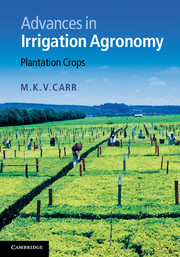1 - Introduction
Published online by Cambridge University Press: 05 May 2012
Summary
There are few easily identifiable or accessible sources where the results of international irrigation research have been brought together and interpreted in coherent and useful ways for individual crops. This is in part due to the diversity of sources, and also to the difficulty of reconciling the results of research conducted in contrasting situations, often with insufficient supporting information, to allow the results to be extrapolated to new situations with confidence (Carr, 2000a).
A scientific understanding of the role that water plays in the growth and development of crops is essential, but this knowledge needs to be interpreted and presented as practical advice in a language that can assist planners, irrigation engineers, irrigation agronomists and producers to allocate and use water, whether rainfall or irrigation, effectively and profitably. Communication between the professions attempting to improve irrigation water management for the benefit of the commercial producer and the wider community can always be improved. Field experiments must be designed and managed to quantify with precision the (marketable) yield responses of crops to water. Adequate supporting measurements need to be taken to enable the results to be interpreted and applied with confidence to other locations, or at other times, where the climate, weather and/or soils may be different. Site specific, single discipline, empirical studies should normally be avoided. But, to minimise duplication of effort, existing information on the water relations and irrigation need of individual crops first needs to be collated and interpreted in practically useful ways. This is especially true for plantation crops having international commercial importance (Carr, 2000a).
- Type
- Chapter
- Information
- Advances in Irrigation AgronomyPlantation Crops, pp. 1 - 13Publisher: Cambridge University PressPrint publication year: 2012

